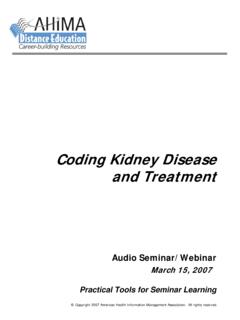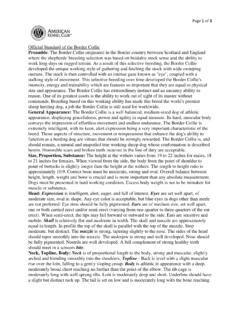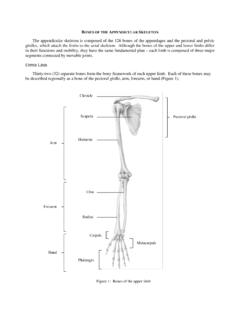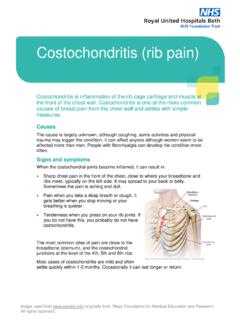Transcription of Early Oral-Motor Interventions for Pediatric Feeding ...
1 JEIBI VOLUME 2, ISSUE NO. 3, Fall, 2005 145 Early Oral-Motor Interventions for Pediatric Feeding Problems: What, When and How Cecilia J. Manno, Catherine Fox, Peggy S. Eicher and MaryLouise E. Kerwin Abstract Children with developmental delays often have Feeding difficulties resulting from Oral-Motor problems. Based on both clinical experience and a review of published studies, Oral-Motor Interventions have been shown to be effective in improving the oral function of preterm infants and children with neuromotor disorders, such as cerebral palsy. However, Oral-Motor problems may be under identified in other populations of children with developmental difficulties. The purpose of this paper is to provide a conceptual framework for understanding Oral-Motor skill development and problems that can occur in any infant and young child and to review Oral-Motor treatment techniques and their empirical support.
2 Keywords: dysphagia, Feeding behavior, oral stimulation, Oral-Motor , behavioral intervention. Oral-Motor problems in children are easy to recognize when the child coughs and chokes while eating. However, the majority of Feeding problems present initially in more subtle ways, such as difficulty introducing spoon feedings or advancing texture, or limited variety of foods accepted (Kerwin, 1999). For some children, these more common Feeding problems may reflect a specific Oral-Motor problem, such as uncoordinated tongue movement during lateralization or dysfunctional oral transport of the food bolus to the back of the mouth to initiate the swallowing reflex. Children with neurological disorders, or those born prematurely often exhibit Oral-Motor problems (Gisel, Alphonce, & Ramsay, 2000; Lau & Hurst, 1999; Sullivan, Lambert, Ford-Adams, Griffiths, & Johnson, 2000). Increasing evidence suggests that Oral-Motor problems are under-recognized in children with problems other than cerebral palsy (Ramsay, Gisel, McCusker, Bellavance, & Platt, 2002; Reilly, Skuse, Wolke, & Stevenson, 1999), including children with autism disorders (Amato & Slavin, 1998).
3 oral motor skills develop within a system that changes rapidly both in structural growth and neurological control during the first three years of life (Arvedson & Lefton-Greif, 1996; Bosma, 1986). During this period, children engage in a great variety of oral motor experiences as they satisfy their basic needs for food and comfort and begin to explore their world. Developmentally, a Feeding problem exists when a child is stuck in their Feeding pattern and cannot progress (Eicher, 2002; Kerwin, 2003; Palmer & Horn, 1977). Because oral motor skills represent a sequential progression of increasingly complex movement patterns, any disruption in practice can interfere with or limit positive oral motor practice, resulting in the loss of advancement in skill development and the learned behaviors that ensue (Illingworth & Lister, 1964). The challenge of treating children with Feeding problems comes in identifying the specific areas that interfere with skill advancement for the individual child (Rudolph & Link, 2002; Stevenson & Allaire, 1991).
4 Understanding each of the active factors interfering with skill advancement and the interaction of those factors enables the treating team to: 1) identify the specific factors contributing to the Feeding problem; and then 2) ameliorate them to allow the child successful practice leading to positive learning, skill advancement and mastery (Kerwin & Eicher, 2004). The following case history will serve as an example of some of the common, but more subtle, oral motor problems in children that require Early , intensive intervention: bottle dependence, difficulty advancing texture, food refusal and food selectivity. Joey is a 4-year-old boy with hypotonia ( , low muscle tone), mild cognitive and motor delays, severe speech delay, poor social relatedness, and a JEIBI VOLUME 2, ISSUE NO. 3, Fall, 2005 146 tendency to perseverate. He will eat only yogurt, Dutch apple dessert and pureed banana baby foods, and will drink only apple juice from a sippy cup.
5 Joey s mother reports that Joey always loved bottle- Feeding , but preferred to drink lying down rather than while being held. He gagged and vomited every time spoon- Feeding was attempted. At 15 months, his parents were able to introduce cream soups with a tablespoon while semi-reclined in a bouncy seat. Through the efforts of weekly Feeding therapy, yogurt and the two fruit baby foods were successfully introduced. He has recently become interested in the green colored small fish crackers, but he only shaves the tails down with his front teeth. At age 2, the pediatrician advised getting rid of the bottle. When his parents stopped offering the bottle, Joey no longer accepted milk. Desperate to get fluids into him, his parents resorted to apple juice via dropper. He now accepts only apple juice and only through a sippy cup while lying down. Joey s Feeding patterns demonstrate components of food refusal, food selectivity, failure to advance texture, and bottle dependence.
6 Despite being four years old and having only mild motor and cognitive delays, Joey is stuck in a very abnormal Feeding pattern with high risk of serious short- and long-term health and developmental consequences. The purpose of this paper is to elucidate the contributing factors to Oral-Motor skill development and practice, review the existing literature for empirical evidence regarding these Interventions , and elaborate on possible intervention strategies that could be used to treat these Feeding difficulties. Development of Oral-Motor Skills Oral-Motor ontogeny follows a stepwise progression building on the suckle reflex to acquire the more complex Oral-Motor milestones suck, munch, and chew (Bosma, 1986; Ogg, 1975). Just as with gross motor skill development, milestone acquisition is not driven by maturation alone. Rather, the emergence of each Oral-Motor milestone is also dependent upon successful practice (Eicher, 2002; Illingworth & Lister, 1964; Pinnington & Hegarty, 2000).
7 Infants are born with a biologically driven suckle reflex which fades around four months of age (Ingram, 1962). When the infant uses the reflex successfully with breast or bottle feedings, they master suckling and its coordination with breathing (Herbst, 1983). In addition, this practice occurs contemporaneously with neuronal growth and development that together enable the infant to acquire volitional control over the suckle response (Arvedson & Lefton-Greif, 1996; Bosma, 1986; Miller, 1993). If an infant does not experience successful practice with the suckle reflex before the reflex fades at four months of age, the suckle pattern may not be mastered (Illingworth & Lister, 1964). As a result, the infants may not be able to successfully initiate nutritive sucking ( , nipple Feeding ) without the propelling effect of the suckle reflex even if the child practiced non-nutritive sucking. This reciprocal, dynamic influence between the child s practice during Feeding and Oral-Motor skill development continues until the child has accomplished the most advanced skill, rotary chewing (Smith, Weber, Newton, & Denny, 1991).
8 Oral-Motor skill development is integrally linked with increasingly complex tongue movements (Gisel et al., 2000; Morris & Klein, 2000). In the typical pattern of development, the tongue first moves liquids through a nipple in an anterior/posterior (in/out) pattern ( , suckling); and then liquids and pureed foods with a superior/inferior (up/down) pattern ( , sucking; Ayano, Tamuro, Ohtsuka, & Mukai, 2000; Tamura, Matsushita, Shinoda, & Yoshida, 1998). The tongue moves chewable foods with a lateral (side to side) pattern over to the molar surface and back to the center, splitting and separating the food until it is ground down enough and recollected to swallow (Ayano et al., 2000). As the child s oral motor function advances, s/he learns to stabilize the jaw, working the tongue off this stable base first centrally with sucking and then laterally with munching (Meyer, 2000; Morris & Klein, 2000). Range of movement increases to allow sweeping anteriorly, posteriorly, laterally, and with tongue tip elevation.
9 In summary, the child s Feeding experience and practice directly influence Oral-Motor pattern and Oral-Motor pattern directly influences Feeding response (Bosma, 1986). If the utensils or food taste and JEIBI VOLUME 2, ISSUE NO. 3, Fall, 2005 147 texture do not change, the child does not learn to accept new foods and does not practice the new patterns necessary to manipulate the new food and transport it through the pharynx safely and efficiently (Gisel et al., 2000). Lack of appropriate and successful practice may result in the loss of previously acquired Oral-Motor skills and/or failure to acquire more advanced skills. Factors Influencing Oral-Motor Skills In addition to appropriate and successful practice, other factors can also negatively influence Oral-Motor skill development. Feeding and swallowing movements and behaviors are very complex and clearly involve much more than just activities in the mouth, throat, and stomach (Gisel, Birnbaum, & Schwartz, 1998).
10 The sensory motor systems provide both the structural foundation and the sensory information that enable a child to practice and master Oral-Motor skills (Morris & Klein, 2000). Because the dynamic Feeding process involves internal activities such as breathing, digestion, and elimination; structural alignment, control and sensory input are important from top to bottom. Structural Alignment In the clinical Feeding lore, there is an old adage, If you want the lips, you must first get the hips, meaning that support for function in the mouth comes from structures below (Morris & Klein, 2000). Biomechanical alignment means that structures of the body are aligned to allow the most efficient muscular interaction. For example, when the pelvis is in a neutral position, the structures of the spine line up biomechanically. A neutral position of the pelvis not only makes sitting up straight much easier, but also provides the spinal alignment and base of support for the rib cage , shoulder girdle, and head position.

















